
Amazon SEO: Organic Growth and Profitability Masterclass
Kristie Schmuck, June 22, 2020
In this 1-hour masterclass, Patrick Quaggin-Smith and Jason Landro from Nectar Consulting teach real strategies that will have an immediate and positive impact on the organic position of your products on Amazon.
This is not your average masterclass. Drawing from their experience managing thousands of clients and millions in ad spend, your instructors divulge their secrets to earning true, incremental growth on Amazon.
You'll learn:
How to Accelerate Organic Rank and Sales with Sponsored Ads
How to build a beautiful foundation even if you have a very large catalogue
How to create brand content that converts (including high quality A+ content)
The most common expensive and deadly mistakes to avoid
Run of Show
01:53 What is organic rank? 04:50 Most important factors influencing organic rank 08:06 Building a beautiful foundation 10:28 Three keys to stunning brand content 12:06 Aligning content to the customer journey 14:44 Photography on mobile vs. desktop: things to remember 16:45 The elements of a bad listing 21:40 Optimizing A+ Content and your Brand Store 23:03 Boosting Organic Rank with Sponsored Ads 27:11 How placements and top-of-search impact organic rank 32:02 How to launch a top-of-search ranking campaign 35:50 How do I know if my product will be competitive on a specific keyword? 39:07 Running a Top-of-Search (Keyword Boost) campaign with Perpetua 40:17 Running a Manual Top-of-Search Campaign 42:06 Measuring TOS Campaign Results & Organic Rank 44:04 Case Study: Hydrant TOS Campaign Results 45:23 Amazon Attribution 50:51 Live Q&A
Full Transcript Below:
[PQS] Organic rank is a topic that we both feel very passionately about is making sure that brands and sellers are doing everything in their power to, to help drive organic growth. Advertising is great, but you're still paying for those sales. We want to make sure that you understand how to unlock the power behind free organic impressions and sales on Amazon.
What is Organic Rank?
Organic rank is the position on which your product appears on an Amazon search results page, excluding the sponsored placements.
The listings that say sponsored are paid placements. Next to those are the first organic listings, meaning the placements that are coming up without paying for that sponsored spot.
The higher you rank organically, the better your position on the page, your gut you'll get three things. One you'll get more impressions, organically. More impressions organically will to lead to higher organic sales. The more eyes you get, assuming you have a somewhat consistent conversion rate, you'll start selling more for free. And then what does that mean? Well, when you start selling more organically, you signal to Amazon that you're relevant for those keywords. Relevancy goes into their bidding process, meaning you're going to pay a lower CPC in the long run for the exact same keyword you've already been bidding on.
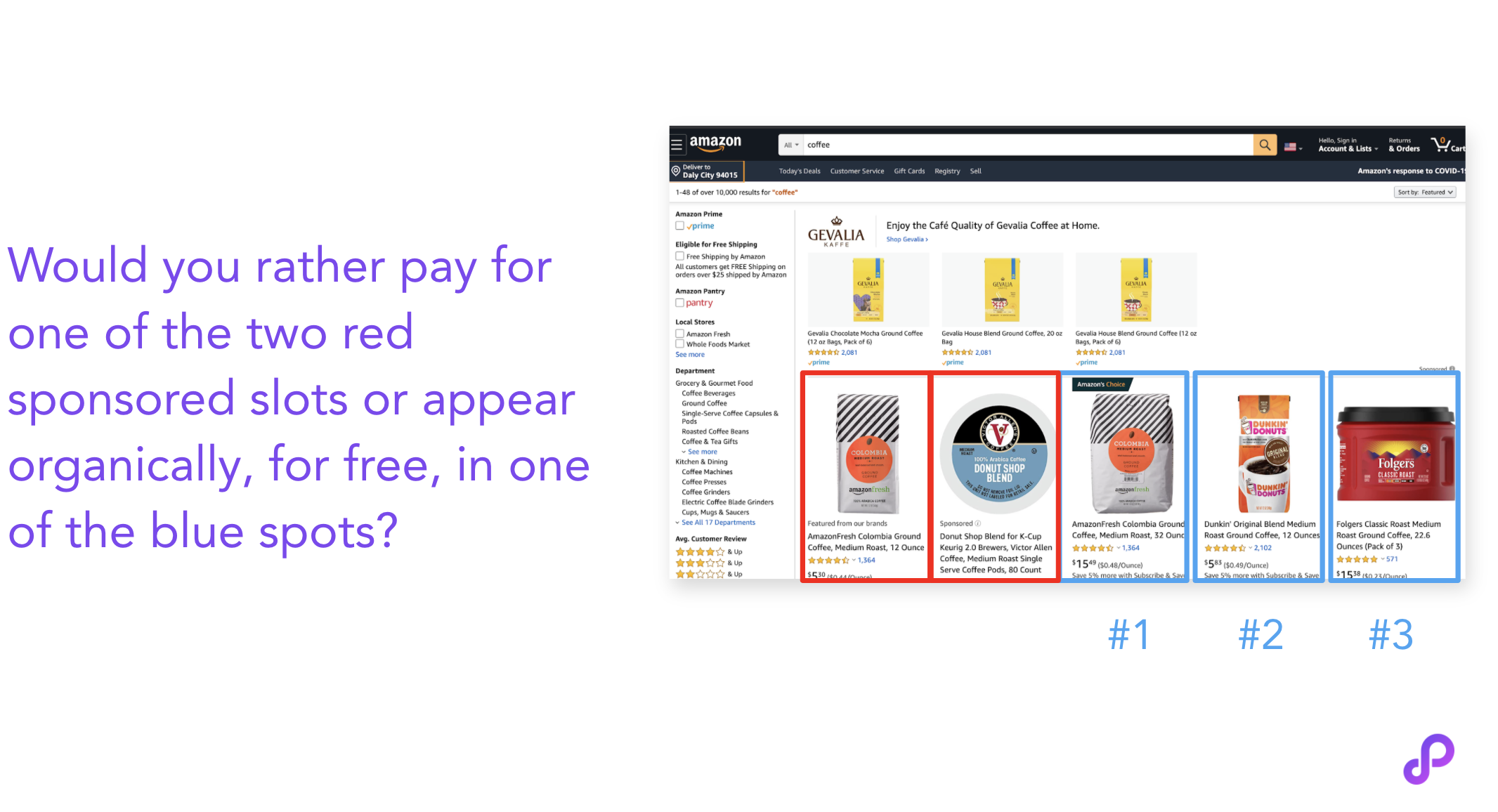
Which factors are most important for organic rank?
So across thousands of accounts, millions and millions of dollars of spend, we look at what factors correlate with increasing organic rank. Click-through Rate (CTR) and Conversion Rate (CVR) are the most important. Everything can almost be classified as a subset of CVR and CTR. Reviews, sales velocity and price points influence CTR and CVR. While all of these factors are important and things that you can influence, it all boils down to really your conversion rate and your click through rate. These metrics will be the focus of how we actually increase our organic rank, and how can we increase them and then in-turn, increase organic rank. We break break this down into two segments; building a beautiful foundation and leveraging sponsored ads.
[JL]
Building a beautiful Foundation
We'll teach you all you need to know about building a beautiful foundation with your product listings, your storefront, your brands. If you have bad listings or a bad storefront, you're just putting yourself in a worse position to have good conversion rates and good click-through rates. If these two things are bad, there is really no point in running sponsored ads as a way of ranking. You might have some success, but if you truly want to excel on Amazon, you need that beautiful foundation first.
It's really important to make sure you're optimizing your listings on a regular basis. Driving traffic is one aspect that you need to master, but you also need to make sure you're converting that traffic. The way that we look at it, and I stress this to our account managers, copywriters are designers, is think about how the customers browse on Amazon. Put yourself in the shoes of a customer. What are you doing when you go on Amazon? What is your browsing behavior? How long do you look at images? Do you skip certain things based on how they look, if it's a wall of text and bullets, do you read those bullets? If there's a ton of text on an infographic. Do you read the text or do you skip over it or do you bounce off the landing page? How do you browse on mobile versus desktop? They look very different. Amazon is one size fits all for both mobile and desktop, so you have to make sure that you're catering to both.
You don't want to show the customer shopping experience to be homework or, or hard, or have friction. You need to keep it simple, you need to have stunning photofraphy and you need good copy.
I see a lot of listings that focus too much on technical specs. Customers know if they want the tech specs, they'll, they'll go to the middle of the page to find them, which is where then you put that information on the backend, unless it's really relevant or niche. You want to focus on those unique value propositions, the benefits. You also want to have a cohesive brand. Customers aren't getting to touch or feel your product. All they get to do is judge the book by its cover.
Most customers also take at least five actions before making a purchase. So you have to make sure that your listings are unified if they're browsing through your catalog. You also need a competitive price, but there is definitely a misconception that only cheap products sell on Amazon. We have a number of clients who are the highest price sellers in their niche and do very well. But to do so, you need to have content that matches your price point.
Three keys to stunning brand content
It needs to be professional, it needs to be captivating and it needs to be simple. You can boil each of these down to three philosophical, psychological principles, ethos, pathos, logos. Ethos is your credibility, pathos is creativity and logos is logic itself. Again, going back to the fact that all customers get to do is judge the book by its cover.
You need to have professional photography. And you'll see a lot of people out there taking pictures on their iPhone and having user generated content. That's not really what customers want to see when they're buying something. Especially if you're the higher priced seller in your niche, you need to have the most professional, captivating images. You need your photo photography to be interesting. You need it to stand out. There's so many options. How are you going to differentiate yourself? So you need to have something that pops.
Your copy also has to be engaging, captivating and simple. Because again, customers don't want to work hard to buy something they want to get. They want to know why they should buy this product and make sure they get the essential information to any common concerns that they have. That's all you need to do. You don't have to overdo it.
Aligning content to the customer journey
I like to approach listing optimization and account optimization in the way that the customer journey takes place. So when you buy something on Amazon, you typically enter a keyword search, or you go to amazon.com and you enter a keyword search. You browse the results. You click into the listing, you browse the listing, you click through some other listings and then you make a purchase.
First thing the customer sees the main image. And we see a lot of people doing this wrong. It has to be high resolution. It needs to be professional. I saw the picture the other day where half the image was on a white background and the other half was on black. That's going to kill your click through rate. You want to take up as much as the frame as possible. This is especially important.
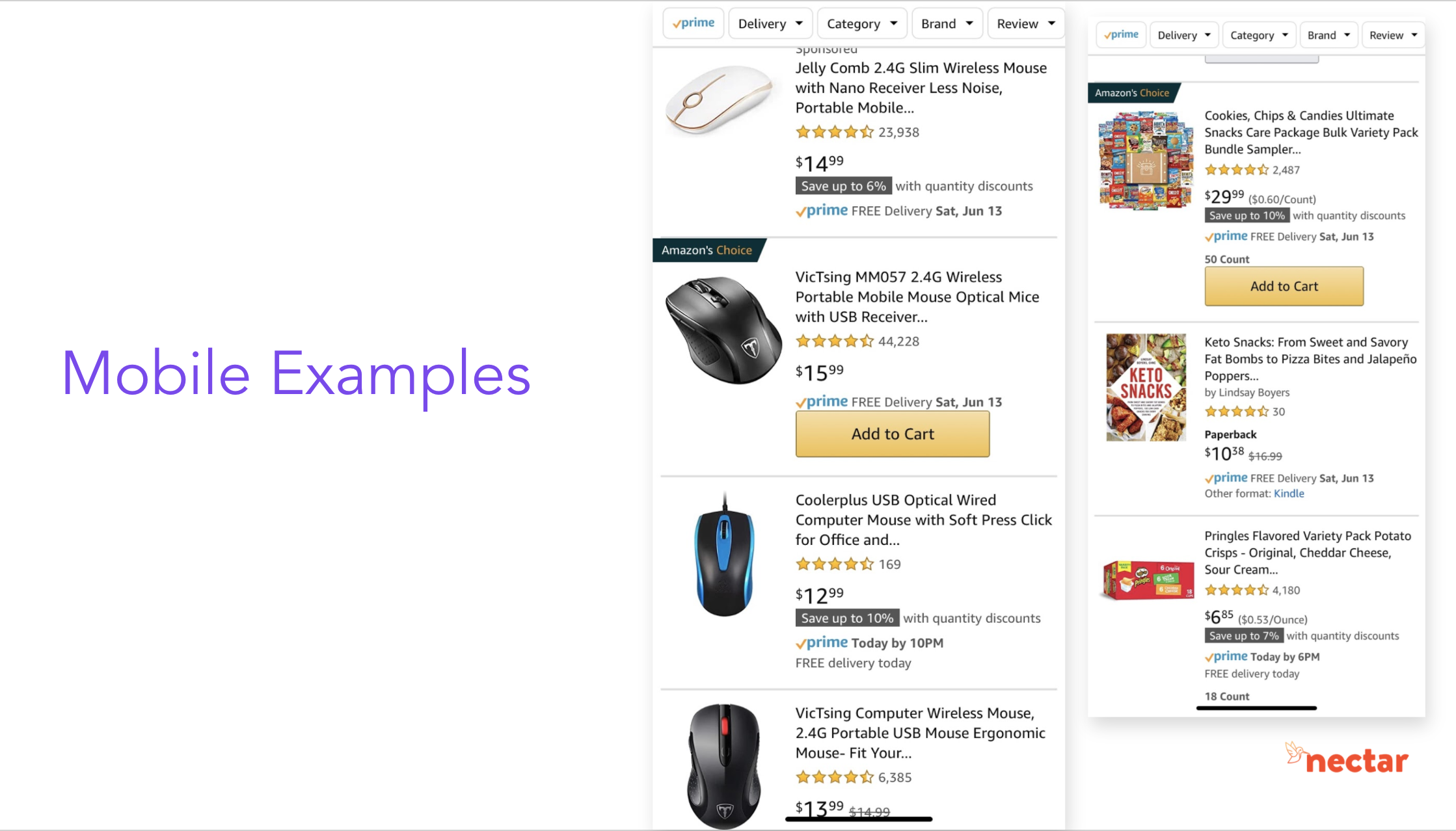
In these examples, it shows why you need to differentiate so that you stand out in the pack. You can see that even without this Amazon's choice, badge, this mouse stands out more because it takes up most of the frame. When a customer's browsing, the mous catches your eye, because it's taking up more of the frame, so it will stop the scroll. If your photo takes up the entire frame, it will have a postiive impact on your CTR.
Photography on mobile vs. desktop: things to remember
You only see the title and the picture for mobile, whereas on desktop, you see the title and the bullet points and the different color variations. You see all the images. When you're crafting your title, you have to keep in mind that mobile customers are only going to see the title.
What I don't like in this example is the big block of text that is really hard to read. You want your most important keywords to be in your title, but have to do a balancing act. In this example, they have PC laptop keywords. Quite frankly, customers who buy a wireless mouse expect it to work with a desktop computer and a laptop computer.
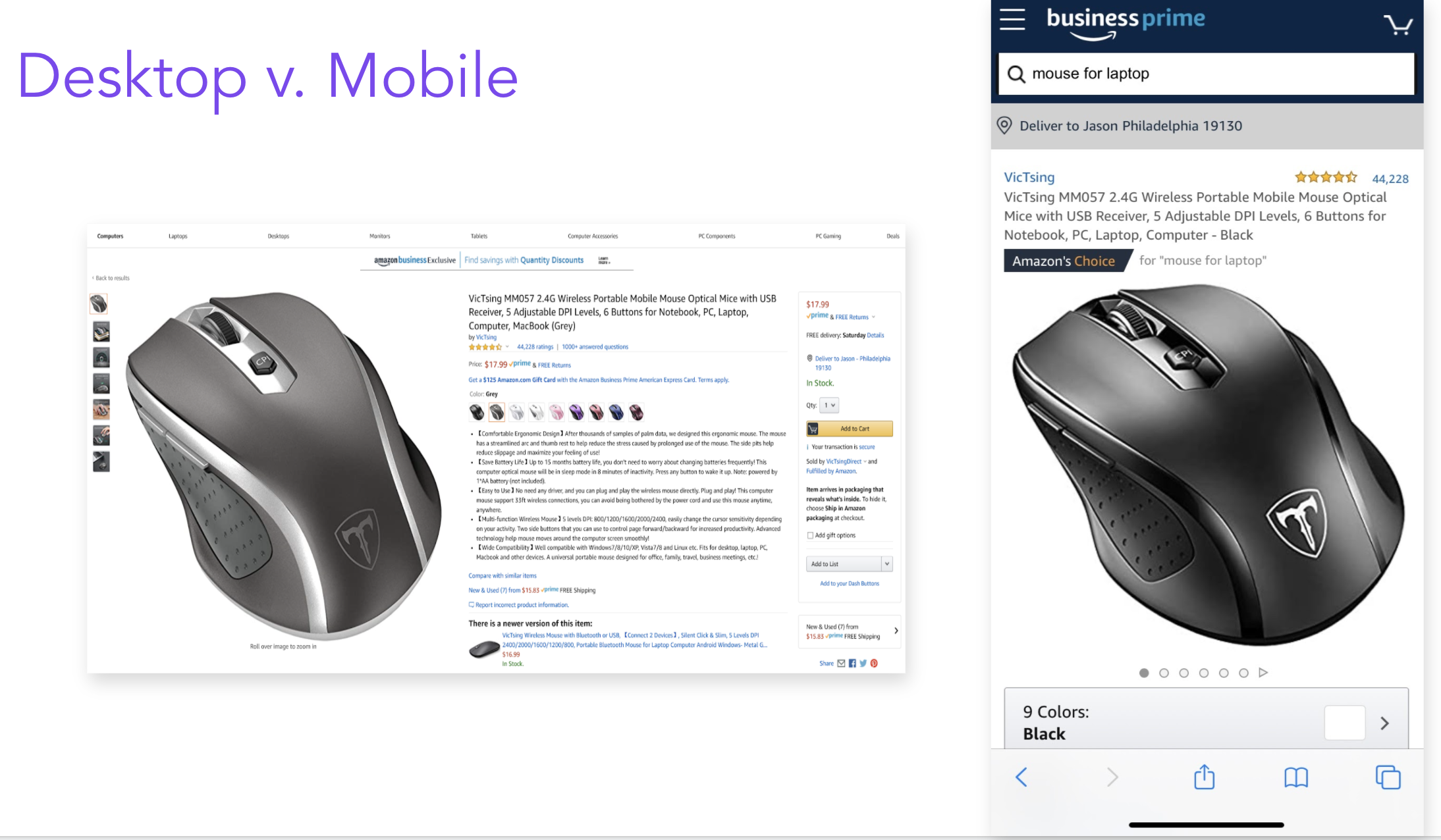
It can be assumed this listing is never going to rank on page one for PC or laptop. These words are unnecessary. You have 200 characters for your title in most categories, apparels and exception. I think it's 80 in some sub apparel categories. You probably want to go over a hundred characters, but you don't want to be much over 150. You have to find that balance.
These rules also apply to bullets. You don't want to have a wall of text. Amazon has actively made changes to reduce text on the page. In almost every category you're allowed 500 bytes, which last was mostly reduced to 100 bytes per bullet point. They (and we) know that customers don't want to read long block text. You need to only include the benefits and what matters, not technical specs.
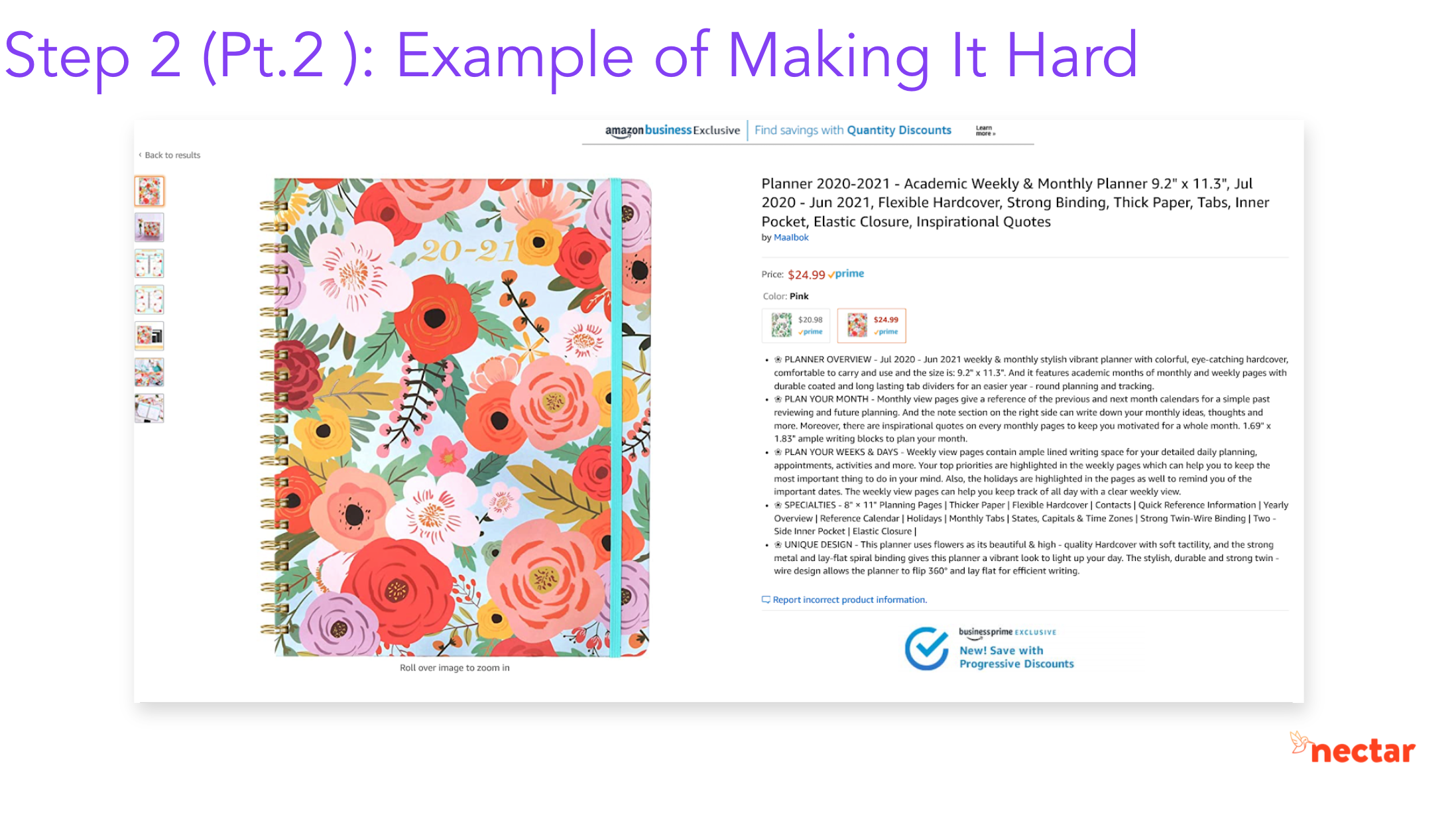
This page has too much text and is overwhelming and I don't know where to start reading. On mobile, it's even worse - this feels like a homework assignment.
Here's an example of making it easy:
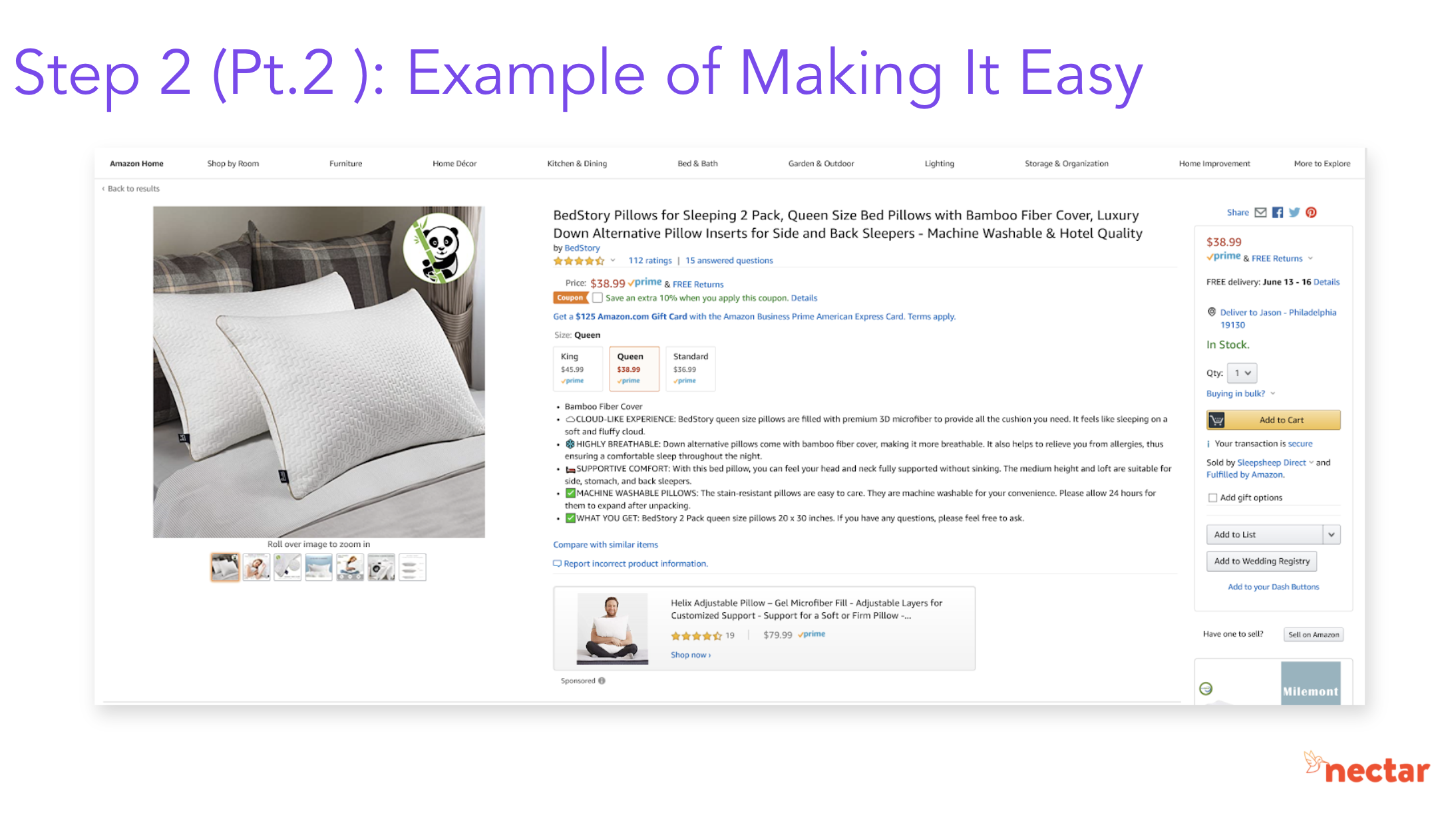
This is actually a little more than a hundred bytes because it's breaking onto a second line, but I like that you have these headlines that guide you. Customers care about the care instructions for pillows, they want to know that it's comfortable and what else they get. Does it come with a cover? Does it not? The customer can look at these headers and decide, do I want to read more?
This listing also has great infographics and photography that are really simple. Less is more, but you want to have a good balance of product photography, infographics, and lifestyle photos. You want your customers, your target audience to imagine themselves using your product. Because they're not going to be in the store holding and touching your product, you have to communicate to them through imagery and video. You want to "Instagram-ify" your listing and inlude varying types of photos in mixed order so that not all product photos are clumped. This way, you can create a feeling and tell a story.
People spend 1-2 seconds looking at product photos before they swipe to the next. Therefore, you need to make sure you're only putting a limited amount of information that can be digested instantly.
The elements of a bad listing
This is an example of what not to do. So all these things are great, right? They have employees based in Florida, they offer a 10 year warranty. They don't pay for reviews, vested in local community. Here's her story, etc.
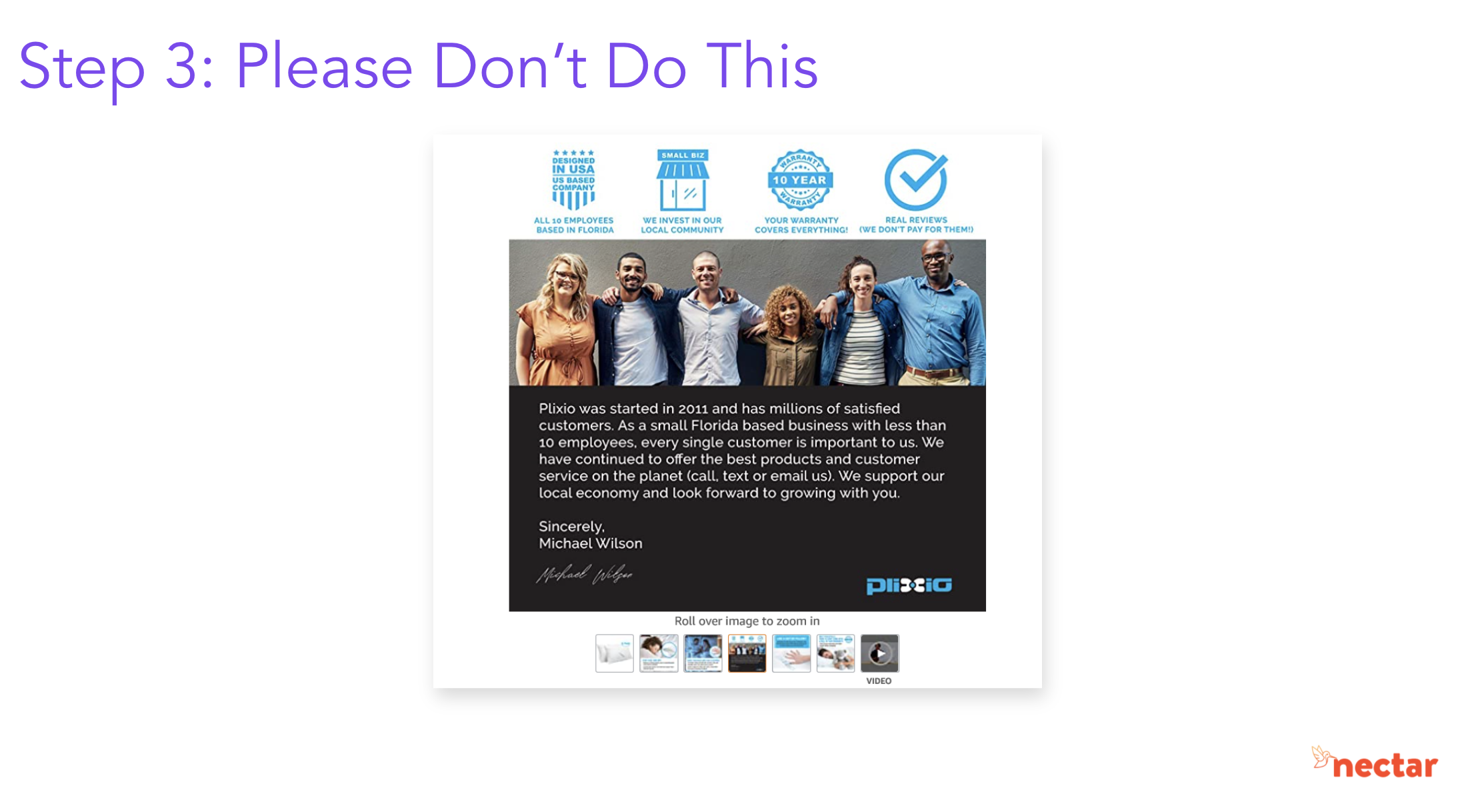
My eye doesn't know where to go. When I look at this image, am I looking at the people? Am I reading ? Do I look at the four logos? So that delays me right there. It's a lot of work and focus. Instead of this, for example, if you're a US-based, you should have a symbol that resonates with your viewers, that they recognize as familiar. You should have a red, white, and blue flag instantly. Or include a warranty symbol. Small biz, same thing. I would take this and cut it into a infographic that focuses on those four key things surrounding the photo — include the symboles, follow the less is more formula and tell the story with A+ content.
Optimizing A+ Content and your Brand Store
We get free advertising real estate with A+ Content. I see a lot of people who don't take advantage of that. They're just telling a story about the product, but you can cross sell your other, related products as well. It's also much more prominent on mobile.
These principles also apply it to a brand store. And we see a lot of success with running traffic to brand stores, especially larger catalogs. Some call it upsell utopia because you can really get customers to buy a lot more if, if you organize your product catalog well. You want the customer to get where they need to go with as few clicks as possibl. Keep in mind, you don't have to do as much selling because the customer has high intent if they're shopping on Amazon. You just need to help them navigate. You should also incorporate video as much as possible.
Here's a good example of a brand store done well - Levi's.
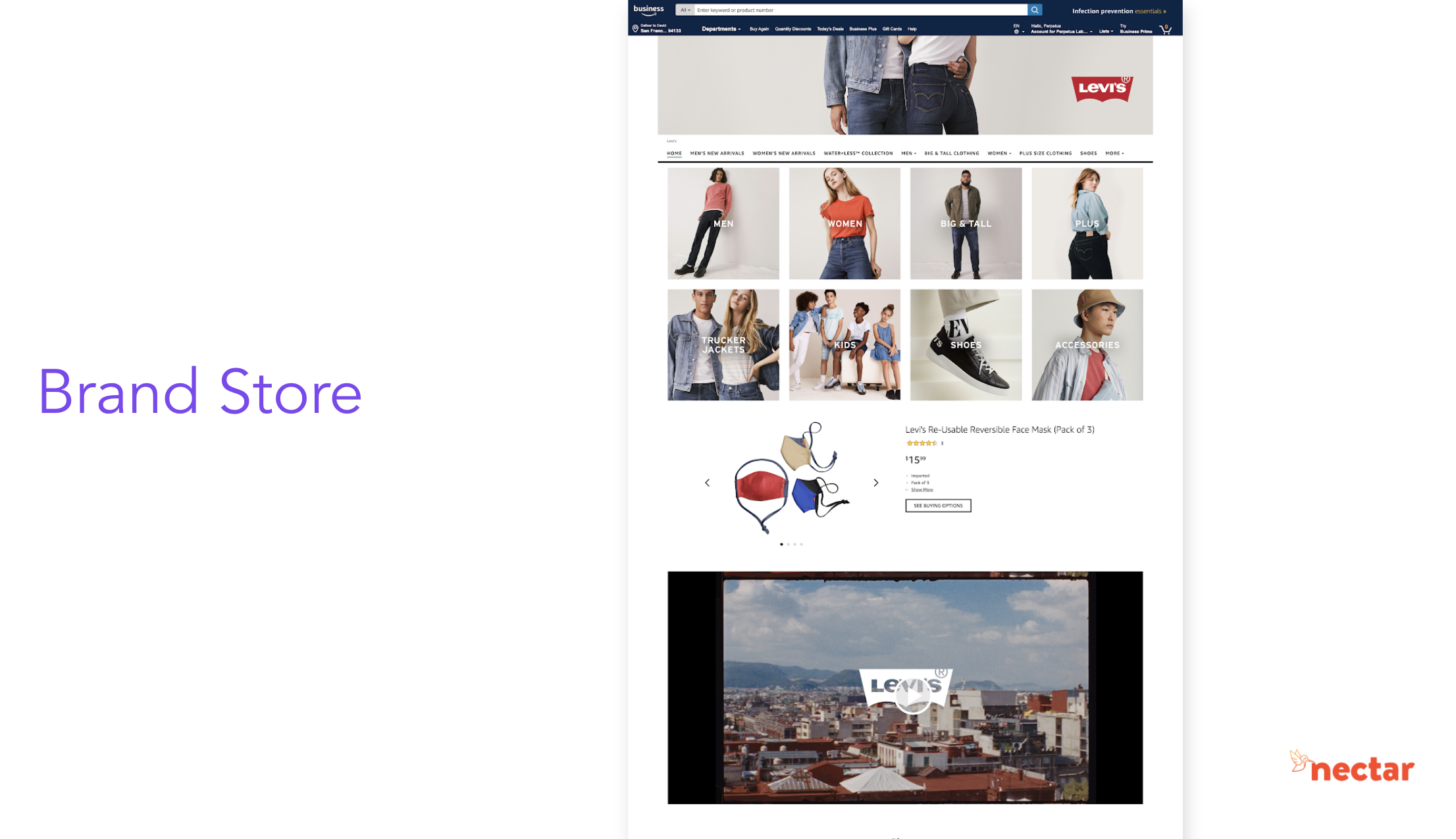
They make it really easy to locate and browse product categories. They are shamelessly promoting their masks right now, but this is somethign you can do with your brandstore - highlight seasonal products or promotions. They've included video that tells the story of their brand. If you'd prefer to shop, you can do that easily as well. You want to make sure your brand store is clean and organized, I can't stress this enough — less is more.
This is great real estate for highlighting sale items or events too. For example, if you're having a fathers day sale you can promote it here. Desiging your store front takes a lot of time to do, but if you do it right, especially if you have a large catalogue, you'll see an increasing in conversions, sales and organic rank.
[PQS]
Boosting Organic Rank with Sponsored Ads
Amazon has so many tools available to to play with, it's unqise to not be optimizing. You can bring someone to the well, but you can't make them drink. But, if you bring someone to a well and it's filled with dirty water — bad listings and brand pages — they definitely won't drink. On the other hand, if you fill the well with Fiji water — a premium content experience — everyone's going to want to drink as much as possible. Of course, in this analogy, the well is your foundation of beautifully designed product listings and content.
Now we'll cover what brings people ot the well — Sponsored Ads. How do we actually leverage advertising to bring people to our listings and generate momentum in the proverbial, Amazon flywheel and on organic rank?
The base theory behind increasing organic rank with sponsored ads is when you start paying for placements, you're going to get more impressions. More impressions lead to more conversions (assuming you've built a beautiful foundation). The most important thing that we've noticed is that not all placements send the same signals and impact your organic rank equally.
How placements and top-of-search impact organic rank
So within a sponsored product ad, you can bid on top-of-search (TOS), rest of search and product page. What we've found is that top of search conversions are a much, much stronger signal to the Amazon algorithm compared to the more browsing-oriented rest of search and product page.
Our theory is that Amazon has audience-based algorithms where if you're buying from a TOS placement, that's a stronger signal that the product is relevant as it's right next to the top organic spots. The lower placements indicate the consumer has been browsing down the page. Or, with a product page, the customer has been clicking into a listing to find other products (browsing).
So in terms of relevance and providing more data for their ranking algorithms, the TOS will disproportionately affect that. When we're thinking about how are we going to leverage sponsored ads, we need to be focusing almost exclusively on our TOS, while not entirely forgetting about rest of search or product page for driving good efficiency.
How to launch a top-of-search ranking campaign
The first step is to decide which keyword you want to rank for. Here are some elements that factor into the decision:
Daily Search Volume - high volume suggests a large market to capture. Of course, the larger the volume the higher the competition will be, but the greater the results wil be in the long run.
Relevance - how relevant is your product to the keyword? For example, if I'm selling an iPhone case, although Android case might have really high search volume, it doesn't make sense for me to try and rank on Android case because sure they're in the same overall field, but I'm not an Android case. I'm an iPhone case.
Current Organic Rank - if you're already ranking very high for a keyword, you may not find much incremental growth by bidding on that same keyword.
I was recently gifted a wireless charger from Belkin and I love it. I searched for the Belkin Amazon storefront and it's amazing. They have great brand content, great listings. Then I looked further into how their product ranks organically, and noticed that it's not even ranking on the first page for the keyword wireless chargers. This is a great opportunity and a perfect example of a product that could benefit from a top-of-search campaign.
So for the purpose of this masterclass, I'll use the Belkin wireless charger as our example. First we need to identify hero keywords. To find hero keywords, you'll look in these three places:
The first place to look is in your existing ad data. Here you could see that iPhone 11 charger has high search volume, but you're not currently ranking high organically for that keyword. Since your product is extremely relevant, this is a good candidate for keyword boost (or top-of-search campaign).
The second place to look is Brand Analytics. Not all sellers have access to this dataset as brand registry is required, but if you do, this is an excellent source for keyword research. Using our Belkin example, I searched the keyword wireless charger. Here I can see the search rank of this keyword, as well as the ASINs that are currently ranked for it. I'm also able to see a list of category keywords related to wireless charger, which could all be good candidates for top-of-search campaigns. We generally recommend anything below 50,000 as this will drive substantial search volumen. The closer to one, the higher the rank, the more searches it has per month.
The third way is to search by competitor ASIN. This gives us search terms that ASIN ranks in the top three results organically for. Here we can see key charger for the first time in any of our searches. This is relevant to our product, has substantial volume and would also be a great candidate for a top-of-search campaign.
The combination of these three sources will give you a very thorough dataset to experiment with.
How do I know if my product will be competitive on a specific keyword?
In our example, the keyword we've chosen is wireless charger, which is the top ranked keyword in the brand analytics dataset. So now we need to determine if our product will be competitive.
How are you priced compared to other results? If every other charger in the top 100 is $8 and you're priced at $40, your click-through rate will suffer. This indicates that the consumer is price conscious, so you'll need to adjust your pricing to ensure you're in the competitive range.
Next factor to consider are reviews. You might struggle to covnert on this keyword if you're surrounded by products that have been on Amazon since the begining of time and have 25,000+ reviews, even if you have 500 yourself.
In our example, we'll look at the two highest organically ranked products and test our listing against the factors noted above.
Our Belkin Wireless Charger is significantly higher priced than then the #1 product listing. We won't compete well in terms of price, but we are priced lower than the listing the #2 spot, which is promising.
The listing that is priced higher has only 20 reviews compared to our 500+. This shows that we will be competitive here.
Our listing is highly relevant — we are a wireless charger amongst other wireless chargers.
Given that we index well in terms of reviews, price and, and listing relevance, wireless charger is an ideal keyword for our product.
Running a Top-of-Search (Keyword Boost) campaign with Perpetua
In Perpetua, we call a top-of-search ranking campaign Keyword Boost. It's a feature that's available for any goal that you're running. So in our example, we've selected wireless charger, so we'll add that. You can add as many keywords as you'd like to boost. I generally recommend being granular and running 1 boost per keyword, so that you have a concise analysis of each keyword.
We then ask you to set a target ACOS, Bid Price and Top-of-Search (TOS) multiplier. The automatic multiplier in this instance is calculated by Perpetua's always-on optimization. We highly recommend letting our ad engine determine the most efficient TOS multiplier.
But if you have strong intuitions about how much you want to be spending on TOS, you can apply these multipliers here. If you have specific ranking strategies, we can actually change this in the backend to go as high as 900%. What this looks like on Amazon is as follows.
Running a Manual Top-of-Search Campaign
Within your existing campaign, you would pause that keyword, you would then launch a new campaign with that individual keyword you want to rank on. And then you're going to set a low bid price with a high TOS multiplier. So what this allows you to do is effectively funnel your spend towards that TOS. So let's say you want it to be bidding $10 on a keyword for TOS, but you don't want to be spending too much on rest of search or product page. You could select a $1 and 10 cent bid and then apply a 900% multiplier. Then you'll be bidding so much on the TOS while simultaneously not bidding super aggressively on the rest of search or product page.
Measuring TOS Campaign Results
Once you launch that campaign, generally, you're not going to see results overnight, but this is kind of a biweekly monthly process where you're going to iterate, maybe experiment getting up 10, 20, 30%, maybe bidding down 10, 20, 30%, and then you're going to be analyzing other metrics.
The metrics that we look at in Perpetua are as follows, broken down into metrics that we provide and the metrics that you can find an Amazon. Something that we're super proud of is a partnership with a third party data source to provide organic rank data for all of your keywords, which is a critical datapoint for measuring the effectiveness of your TOS campaign.
In Perpetua, we pull this five times per day, and it's averaged across all geographies per marketplace. This considers that you might rank first in New York, but may be ranked fifth in Los Angeles. We'll actually take the average across the entire US.
For our TOS, you're going to one to check to see if organic rank is increasing, and then you're going to want to look at your sponsored rank. Before you start spending on rest of the search or product page, we want to make sure that you're ranking in the top three spots. If organic rank is increasing, you can look to see the value of that increase.
Next we'll look at share of voice. This is something that's more important to larger brands, but can be applicable and important to all brands and sellers. This is used to determine what percentage of that page you own. If we're trying to buy more top of search placements, we should see our percentage of top of search increase.
We should be winning increasing percentage of share of voice, because again, that's what's going to feed that organic rank, which is going to boost all of the other metrics.
Additionally, we like to look at a blended daily ACOS. This will help us determine much profitability to sacrifice when you're running these campaigns. From my perspective, it's worth it to invest for a little bit of time, but if you're finding that this is becoming unprofitable in the hope of gaining organic rank in the long run, then this probably isn't the best strategy. This is why analyzing all of these metrics are super important in addition to keeping an eye on total sales.
Now I'll prove it to you that this actually does work, and we're not just saying this. Read the full Hydrant case study here.
They were ranking on the second page organically, and were advertising, but weren't focusing too much on TOS. They were optimizing for for overall efficiency. Their agency (a Perpetua user) ran a keyword boost, which is that exact type of ranking strategy I just mentioned, and there were the results. TOS campaign was launched February 20th and you'll see just how much of an increase they saw, not only in organic sales, but in organic rank and sales.
They say 100% increase in daily, organic sales on the keyword electrolyte powder, and 40% higher organic rank. Before this experiment, they were winning 0% top of search share of voice and it climbed to 25%. Then Hydrant's best seller rank and electrolyte supplements went from 12,000 to 5,000, which you know, for running this type of ranking strategy just shows you how much of an impact you can have even with the really high high volume, highly competitive keywords.
Live Q&A
Q: Does the Perpetua ad engine optimize for organic rank?
A: Our engine currently doesn't optimize for organic rank, but in the coming weeks, we will have the ability for clients to set in those types of recommendations. So if you want to try to rank first organically you could tell our engine and our always-on optimization will go out and actually make the necessary changes in campaigns to try to rank you first, organically.
Q: Does ZonRanker work for vendors?
A: Yes, but you have to contact us directly. This is built for seller central to verify order ideas, which you don't have in vendor central.
Q: Can I use bid multiplier for top of search at the ad group level?
A: Yes you can. But we generally recommend launching on individual keyword campaigns because you become more granular and you can easily analyze the results. If you apply a top of search multiplier on an ad group containing 10 20, 30 keywords, you're going to focus that on all of the keywords that you might not want to be ranking for. Iit's better to create these individual campaigns so you can quantify each keyword and make sure that your investment is worth it.
Q: Is Perpetua used by advertisers, or do we need your team to manage our campaigns?
A: Perpetua is a beautiful, user friendly app. Our goal is to make it as easy as posting a photo on Instagram, as it is to run a top of search campaign as it is to launch a sponsored brand video campaign. So if you guys explore our app at all, you'll see just how easy that is. And we really pride ourselves on being a very consumer friendly app for people to use and to really drive the world's best Amazon strategies.
Q: How much should you spend in a ranking campaign with no positive effects before quitting?
A: Generally, I'd say you should see some influence within the first seven days. If you spend a lot of money in seven days and you see no results something is wrong. So launch and monitor. I wouldn't even start monitoring for the first 48 hours because of the attribution window. So there's nothing that we can definitively say after 48 hours. On the third day, go and see how it's doing, make some small changes. Perpetua might be saying bid 5% higher, 10% higher, and within Amazon that might be increasing it 10 cents 20 cents. Then wait another 48 hours you should see, is this working or not? At that point, you should start seeing some initial positive results, try to fine tune it for like a month. Conversely, if results aren’t good after a week, stop it.
Another indicator is if you’re seeing some results on a keyword, but not enough that you're not ready to go after it aggressively. You might need more reviews or you might need to make some tweaks in your listing. So, if your click through rate is good, but you're not getting enough conversions that tells you there's something wrong with your landing page. If your click through rate is not good, maybe your main image needs to be optimized. Just make sure you’re looking at all the data.
Q: For bullets within listings, we’ve heard include keywords and utilize most, if not all, the space Amazon provides. You mentioned the importance of short and simple, simple bullets. Is it important to include keywords or is it more important to briefly highlight key points?
A: You have to strike a balance. You can see the character count If you click on edit listing and edit, the story page. Go to the tab where you can edit the bullet points, you'll see a question symbol. If you hover over it, it'll tell you the character or the byte limit for each of the bullet points, if you know what that is you’ll want to adhere to that. And if you're in a subcategory where you're allowed 500 characters per bullet point, which is a lot, you have to make a decision. You can split test and see what performs better. But keep in mind that Amazon has pushed everyone to, you know, simplify, do less. They’ve brought the character counts down, and then they want content to be more engaging and less cumbersome. Remember that you have 250 bytes for the search terms in the backend and you can make up those, those keywords there.
Q: What percentage of budget would you recommend utilizing for top of search campaign? And at what ACOS?
A: Generally, I'd say bid more aggressively than you are currently bidding. So if you were bidding $5 on that keyword across all placements, you know, maybe bid $2, but apply a 300, 400% multiplier. So you're bidding $6 to $8. So bidding more aggressively than you are currently bidding. And then in terms of budget, generally, it's going to be case to case dependent based on what you're currently spending and how much you can spend, but I'd say give it a healthy budget, maybe 15%-20% of what you were spending on that campaign as a whole across all your keywords. If you're attacking a high-volume keyword, the second you start bidding those buying those impressions. If you have that click through rate, you're going to start spending a lot more. So just being able to not, not make your campaigns go dark too early on.
To get started or learn more about how Perpetua can help you scale your Amazon Advertising business